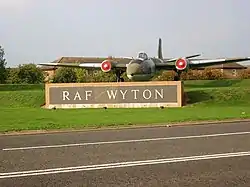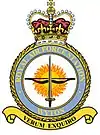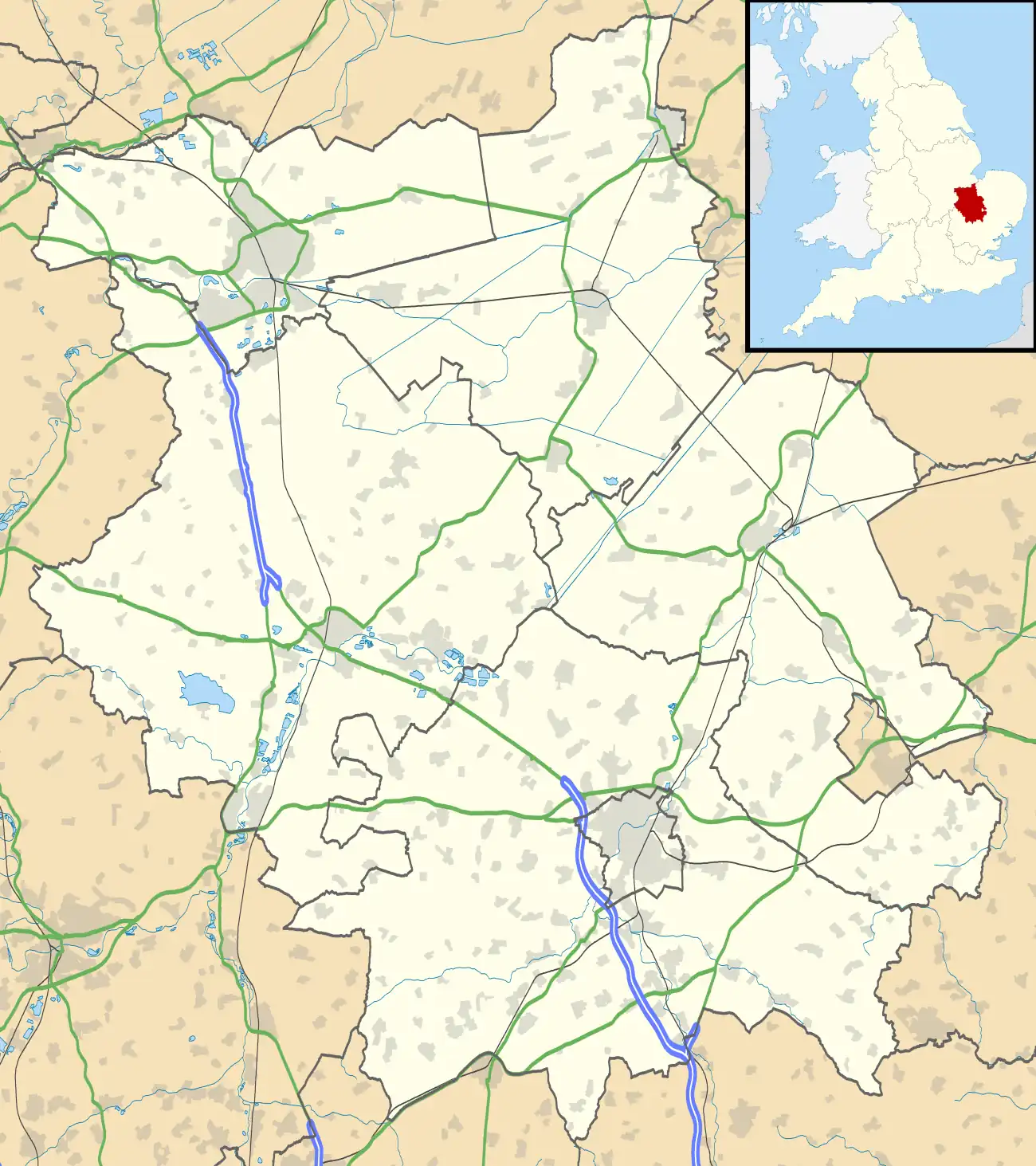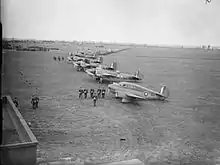RAF Wyton
Royal Air Force Wyton or more simply RAF Wyton (IATA: QUY, ICAO: EGUY) is a Royal Air Force station near St Ives, Cambridgeshire, England. The airfield is decommissioned and is now used by the UK Strategic Command.
| RAF Wyton | |||||||
|---|---|---|---|---|---|---|---|
| Near St Ives, Cambridgeshire in England | |||||||
 Canberra PR9 'XH170' which is RAF Wyton's gate guardian | |||||||
 | |||||||
 RAF Wyton Shown within Cambridgeshire | |||||||
| Coordinates | 52°21′26″N 000°06′28″W | ||||||
| Type | Royal Air Force station | ||||||
| Site information | |||||||
| Owner | Ministry of Defence | ||||||
| Operator | Royal Air Force | ||||||
| Controlled by | Strategic Command | ||||||
| Condition | Operational | ||||||
| Website | www | ||||||
| Site history | |||||||
| Built | 1915 | ||||||
| In use | 1916 – present | ||||||
| Garrison information | |||||||
| Current commander | Wing Commander Keith Slack | ||||||
| Occupants |
| ||||||
| Airfield information | |||||||
| Identifiers | IATA: QUY, ICAO: EGUY, WMO: 03566 | ||||||
| Elevation | 40.2 metres (132 ft) AMSL | ||||||
| |||||||
| Source: RAF Wyton Defence Aerodrome Manual[2] | |||||||
History
Flying station

.jpg.webp)
Wyton has been a military airfield since 1916, when it was used for training by the Royal Flying Corps and then its successor the Royal Air Force (RAF).[3]
The following squadrons were posted to Wyton between 1916 and 1935:
- No. 46 Squadron RFC between 1916 and 1916.[4]
- No. 65 Squadron RFC between 1916 and 1917.[5]
- No. 83 Squadron RFC between 1917 and 1917.[6]
- No. 96 Squadron RAF between 1918 and 1918.[7]
- No. 104 Squadron RFC between 1917 and 1917.[8]
- No. 117 Squadron RAF between 1918 and 1919.[9]
- No. 119 Squadron RAF between 1918 and 1918.[9]
- No. 120 Squadron RAF between 1918 and 1918.[9]
- No. 130 Squadron RAF between 1918 and 1918.[10]
- No. 156 Squadron RAF between 1918 and 1918.[11]
- No. 211 Squadron RAF between 1919 and 1919.[12]
- Second World War
During the Second World War it was used primarily as a bomber base, flying Bristol Blenheim, de Havilland Mosquito and Avro Lancaster aircraft.[13] In 1942 it became the home of the Pathfinder Force under the command of Group Captain Don Bennett.[3]
The following squadrons were posted to Wyton between 1935 and 1939:
- No. 44 Squadron between 1937 and 1937.[14]
- No. 114 Squadron between 1936 and 1939.[9]
- No. 139 Squadron between 1936 and 1939.[15]
The following squadrons were posted to Wyton between 1939 and 1945:
- No. 15 Squadron between 1939 and 1940.[16]
- No. 15 Squadron for a second time between 1940 and 1942.[16]
- No. 40 Squadron between 1939 and 1941.[17]
- No. 57 Squadron between 1940 and 1940.[18]
- No. 57 Squadron for a second time between 1940 and 1940.[18]
- No. 83 Squadron for a second time between 1942 and 1944.[6]
- No. 105 Squadron between 1942 and 1945
- No. 109 Squadron between 1942 and 1942.[19]
- No. 109 Squadron for a second time between 1942 and 1943.[19]
- No. 128 Squadron between 1944 and 1945.[10]
- No. 139 Squadron for a second time between 1943 and 1944.[15]
- No. 156 Squadron for a second time between 1945 and 1945.[11]
- No. 163 Squadron between 1945 and 1945.[20]
- Cold War
After the war Wyton became home to the English Electric Canberras of the Strategic Reconnaissance Force.[21] Vickers Valiants arrived for No. 543 Squadron in 1955 and a Handley Page Victor arrived for the Radar Reconnaissance Flight in 1959.[21]
In 1974, three Nimrod R1s belonging to No. 51 Squadron arrived for use in the Elint and Sigint role, and in 1975, the T17 and T17A Canberras of No. 360 Squadron arrived: this was a joint RAF and RN Squadron specialising in Electronic countermeasures training.[21]
The following squadrons were posted to Wyton between 1946 and 2011:
- No. 13 Squadron between 1978 and 1982.[22]
- No. 15 Squadron for a third time between 1946 and 1950.[16]
- No. 25 Squadron between 1983 and 1989.[23]
- No. 26 Squadron between 1969 and 1976.[23]
- No. 39 Squadron between 1970 and 1982.[17]
- No. 44 Squadron for a second time between 1946 and 1951.[14]
- No. 51 Squadron between 1963 and 1995.[24]
- No. 58 Squadron between 1953 and 1970.[18]
- No. 82 Squadron between 1953 and 1956.[6]
- No. 85 Squadron between 1989 and 1991[25]
- No. 90 Squadron between 1946 and 1950.[26]
- No. 100 Squadron between 1956 and 1956.[8]
- No. 100 Squadron for a second time between 1982 and 19??.[8]
- No. 138 Squadron between 1946 and 1950.[15]
- No. 207 Squadron between 1969 and 1984.[27]
- No. 360 Squadron between 1975 and 19??.[28]
- No. 540 Squadron between 1953 and 1956.[29]
- No. 542 Squadron between 1954 and 1955.[30]
- No. 542 Squadron for a second time between 1955 and 1955.[30]
- No. 543 Squadron between 1955 and 1974.[30]
- 21st century
In the early 1990s one of its pilots was rugby union player Flight Lieutenant Rory Underwood.[31]
During a four-month period in 1989, two squadrons of U.S. Air Force Fairchild Republic A-10 Thunderbolt II jets were operated out of RAF Wyton while the runway at their base, nearby RAF Alconbury, was resurfaced.[32]
In May 1995 both RAF Wyton and RAF Alconbury airfields were decommissioned and Wyton was formally amalgamated with RAF Brampton, and later with RAF Henlow to make all three locations a single RAF Station under a single station commander for administrative purposes.[33] The airfield continued to host light aircraft for the Cambridge and London University Air Squadrons until they both moved to RAF Wittering in 2015.[34]
2011–present
Following the 2010 Strategic Defence and Security Review the RAF Brampton Wyton Henlow formation was disbanded: RAF Henlow subsequently became a separate station again and RAF Brampton was demolished.[35]
The Joint Forces Intelligence Group, a unit which is responsible for the collection of signals, geospatial, imagery and measurement and signature intelligence,[36] moved from Feltham in Middlesex to RAF Wyton in 2013.[37][38] 42 Engineer Regiment relocated from Denison Barracks in Hermitage to RAF Wyton to co-locate with the Joint Forces Intelligence Group in July 2014[39] and No. 1 Intelligence Surveillance Reconnaissance Squadron moved from RAF Marham to Wyton in April 2017.[40]

Former units
Other units moved (now disbanded)
The following other units were posted to Wyton at some point:[41]
- No. 1 Photographic Reconnaissance Unit RAF (June 1982 - July 1992)[42]
- No. 2 Group Communication Flight RAF (January 1940 - May 1943)[43]
- No. 4 Blind Approach Training Flight RAF became No. 1504 (Beam Approach Training) Flight RAF (December 1940 - August 1942)[44]
- No. 7 Group Communication Flight RAF (July 1940 - September 1941)[43]
- 8th Aero Squadron
- No. 8 Group Communication Flight RAF (August 1942 - October 1945)[43]
- No. 8 (Pathfinder Force) Group RAF (August 1942 - May 1943)[45]
- No. 13 Aircraft Modification Unit RAF (March - August 1946)[46]
- No. 70 (Bomber) Wing RAF
- No. 231 Operational Conversion Unit RAF (July 1982 - December 1990, May 1991 - April 1993)[47]
- No. 1323 (Canberra) Flight RAF (October 1953 - November 1955)[48]
- No. 1409 (Meteorological) Flight RAF (January - July 1945)[49]
- No. 1499 (Bombing) Gunnery Flight RAF (March - June 1943)[44]
- No. 1655 Mosquito Training Unit RAF
- No. 2730 Squadron RAF Regiment
- No. 2763 Squadron RAF Regiment
- No. 2781 Squadron RAF Regiment
- No. 2844 Squadron RAF Regiment
- Canberra Air Race Flight RAF (June - October 1953)[50]
- Canberra Standardisation and Training Flight RAF (December 1990 - May 1991)[50]
- Electronic Warfare Division RAF became Electronic Warfare Detachment RAF (Unknown - December 1994)[51]
- Electronic Warfare Engineering and Training Unit RAF (-1976) became Electronic Warfare and Avionics Unit RAF (1976-1993)[51]
- Electronic Warfare Operational Support Establishment RAF (1983-1995) becoming part of Air Warfare Centre 1993[51]
- Equipment Support (Air) Group RAF (November 1999 - unknown)[52]
- Ground Controlled Approach Operators School RAF (March 1952)[53]
- Logistics Command RAF (April 1995 - April 2000)[54]
- Radar Reconnaissance Flight RAF (October 1955 - September 1961)[55]
- Cambridgeshire Police Air Operations Unit
Currently operational units moved
On 25 March 2013 it was decided to relocate the following flying units from Wyton due to the high maintenance costs of the airfield.[56]
- 57(R) Squadron relocated to RAF Cranwell in Summer 2013.[56]
- Cambridge University Air Squadron relocated to RAF Wittering in mid-2014.[56]
- University of London Air Squadron relocated to RAF Wittering in mid-2014.[56]
- 5 Air Experience Flight also relocated to RAF Wittering in mid-2014.[56]
Based units
Notable units based at RAF Wyton.[57][40][58]
Strategic Command
Royal Air Force
|
British Army
Ministry of Defence
United States Department of Defense
|
References
Citations
- Pine, L.G. (1983). A dictionary of mottoes (1 ed.). London: Routledge & Kegan Paul. p. 249. ISBN 0-7100-9339-X.
- "RAF Wyton Defence Aerodrome Manual (DAM)" (PDF). RAF Wyton. Military Aviation Authority. 31 March 2016. Archived from the original (PDF) on 28 August 2017. Retrieved 27 August 2017.
- "RAF Wyton". Royal Air Force. Retrieved 26 November 2021.
- Jefford 1988, p. 40.
- Jefford 1988, p. 45.
- Jefford 1988, p. 50.
- Jefford 1988, p. 53.
- Jefford 1988, p. 54.
- Jefford 1988, p. 57.
- Jefford 1988, p. 59.
- Jefford 1988, p. 63.
- Jefford 1988, p. 70.
- "Avro Lancaster B.Mk.1 R5868/7325M Museum Accession Number 74/A/12" (PDF). RAF Museum. p. 3. Retrieved 26 November 2021.
- Jefford 1988, p. 39.
- Jefford 1988, p. 60.
- Jefford 1988, p. 29.
- Jefford 1988, p. 38.
- Jefford 1988, p. 43.
- Jefford 1988, p. 55.
- Jefford 1988, p. 64.
- "RAF Wyton". Vulcan to the Sky Trust. Retrieved 26 November 2021.
- Jefford 1988, p. 28.
- Jefford 1988, p. 33.
- Jefford 1988, p. 41.
- Raynham News (1991). "RAF West Raynham Missile Squadron to be Disbanded" (PDF). Retrieved 28 August 2018.
- Jefford 1988, p. 52.
- Jefford 1988, p. 69.
- Jefford 1988, p. 89.
- Jefford 1988, p. 96.
- Jefford 1988, p. 97.
- "Sport. Rugby Union. pic: January 1989. RAF. Wyton, Cambridgeshire. England wing Rory Underwood, a pilot flight-lieutenant in the RAF, poses in the cockpit his Canberra jet". Getty Images. Retrieved 26 November 2021.
- "A-10A Thunderbolt of 511th Tactical Fighter Squadron/10th Tactical Fighter Wing on detachment to RAF Wyton in May 1989". Airport Data. Retrieved 26 November 2021.
- "Air Officer Scotland: Air Vice Marshal Ross Paterson". Royal Air Force. Retrieved 26 November 2021.
- "University of London Air Squadron". Retrieved 26 November 2021.
- "Dramatic Footage Shows Demolition Of RAF Base". 13 January 2017.
- "Joint Forces Intelligence Group Achieves Full Operating Capability". Ministry of Defence. 22 September 2014. Archived from the original on 4 March 2016. Retrieved 7 November 2015.
- "New Defence Intelligence buildings handed over to MOD". Ministry of Defence. 16 March 2012. Retrieved 4 November 2014.
- "UK JARIC Transitions to Defence Geospatial and Intelligence Fusion Centre" (PDF). November 2012. Archived from the original (PDF) on 16 February 2013.
- "42 Engr Regt (Geo) arrive at RAF Wyton". Eagleeyeonline.vo.uk. Archived from the original on 1 February 2015. Retrieved 16 December 2018.
- Ellwood, Tobias (21 December 2017). "Air Force: Military Intelligence:Written question - 120057". UK Parliament. Retrieved 29 December 2017.
- "Wyton". Airfields of Britain Conservation Trust. Retrieved 10 February 2016.
- Sturtivant & Hamlin 2007, p. 211.
- Sturtivant & Hamlin 2007, p. 155.
- Sturtivant & Hamlin 2007, p. 125.
- Sturtivant & Hamlin 2007, p. 149.
- Sturtivant & Hamlin 2007, p. 42.
- Sturtivant & Hamlin 2007, p. 197.
- Sturtivant & Hamlin 2007, p. 119.
- Sturtivant & Hamlin 2007, p. 120.
- Sturtivant & Hamlin 2007, p. 82.
- Sturtivant & Hamlin 2007, p. 102.
- Sturtivant & Hamlin 2007, p. 108.
- Sturtivant & Hamlin 2007, p. 148.
- Sturtivant & Hamlin 2007, p. 173.
- Sturtivant & Hamlin 2007, p. 213.
- "Defence Estate Rationalisation Update" (PDF). Ministry of Defence (MoD). Retrieved 26 March 2013.
- "RAF Wyton". Royal Air Force. Retrieved 25 April 2021.
- "DCMA United Kingdom | Huntingdon, Cambridgeshire". Defense Contract Management Agency. Retrieved 25 April 2021.
Bibliography
- Jefford, C G (1988). RAF Squadrons. A comprehensive record of the movement and equipment of all RAF squadrons and their antecedents since 1912. Shrewsbury: Airlife. ISBN 1-85310-053-6.
- Lake, A (1999). Flying units of the RAF. Shrewsbury: Airlife. ISBN 1-84037-086-6.
- Sturtivant, R.; Hamlin, J. (2007). Royal Air Force flying training and support units since 1912. UK: Air-Britain (Historians). ISBN 978-0851-3036-59.
- RAF Annual Review 2012
